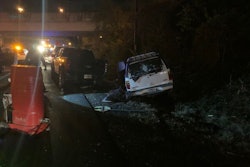 An example of an unsafe trench.
An example of an unsafe trench.This year is starting out to be a costly one for contractors cited for trench violations by the U.S. Occupational Health & Safety Administration.
OSHA issued proposed penalties totaling $264,670 in January for five separate trench collapses, including cave-ins in Alabama that killed two workers and one in Mississippi that killed one worker.
OSHA reported citations were issued to the following contractors in January:
2 die in Alabama trench
 Gaspar Manuel-Pedro
Gaspar Manuel-PedroOn July 23, Gaspar “Leonel” Manuel-Pedro, 46, and Matias “Rafael” Gaspar-Lopez, 28, were working in a 5- to 7-foot-deep trench in Hoover when it caved in. The trench was 70 feet long and 3.5 to 5 feet wide. Spoil piles were up to 5 feet high on both sides of the trench’s edges. There was no protective system in place.
Calloway Inc., dba American Lawn Company, was issued penalties totaling $55,326, and OLA, dba Outdoor Living Areas Inc., faces penalties of $33,156. Both
 Matias Gaspar-Lopez
Matias Gaspar-Lopezcompanies list the same address in Bessemer, Alabama.
Calloway and OLA were each cited for no protective system, not performing daily inspections of the trench, excavated materials within 2 feet of the edge of the trench, no safe means of exiting the trench, workers without hardhats and workers not trained on trench hazards.
Death in Mississippi
Larry Warren Jackson, 52, was standing in the bottom of a 10-foot-deep trench July 8 in Taylor, Mississippi, to install a section of sewer pipe to a new concrete manhole when a trench wall caved in and buried him.
Rhobina Electric of Batesville, Mississippi, was issued penalties totaling $37,318. The OSHA citation listed these violations: no hardhats on workers; workers were not removed from trench that showed signs of collapse and had water intrusion; no cave-in protection system in place; fatality not reported to OSHA within 8 hours by Rhobina; no written hazard-communication program for exposing employees to chemical hazards; and no training on hazardous chemicals used at the jobsite.
No protection for trench with water in it
Also in January, OSHA issued a citation to another Mississippi contractor, Advanced Construction & Development LLC in Biloxi, with proposed penalties of $79,559.
OSHA inspectors visited a jobsite August 27 and found workers installing a drainpipe in a trench in Diberville without cave-in protection. The trench also had water in it that had not been pumped out or been diverted.
Advanced was also cited for no employee training on excavation hazards, no hardhats on employees, employees working underneath a loaded backhoe bucket, employees not removed from a trench that showed signs of fissuring, and no daily trench inspection.
2 workers in unprotected 11-foot excavation
A Pennsylvania contractor, Metarko Excavating of Harmony, was cited in January for $59,311 after OSHA inspectors got a call December 13 that workers were in an unsafe excavation in Cranberry Township.
They found two workers installing sewer line in an 11-foot-deep excavation that had 4 to 6 inches of water in it. Metarko was cited for inadequate cave-in protection for a sidewall cave-in, no safe means for employees to exit the excavation, no training on how to safely use ladders, workers in trench that had water in it and failure to remove workers from area with possible cave-in.
“Working in trenches without all necessary safeguards can result in serious or fatal injuries,” says OSHA Pittsburgh Area Director Christopher Robinson. “Employers must protect workers involved in dangerous excavation work and train their workers properly to recognize and address hazards before entering a trench.”
For more on the business and human costs of trench-collapse fatalities in the United States, see Equipment World’s special report “Death by Trench”.











